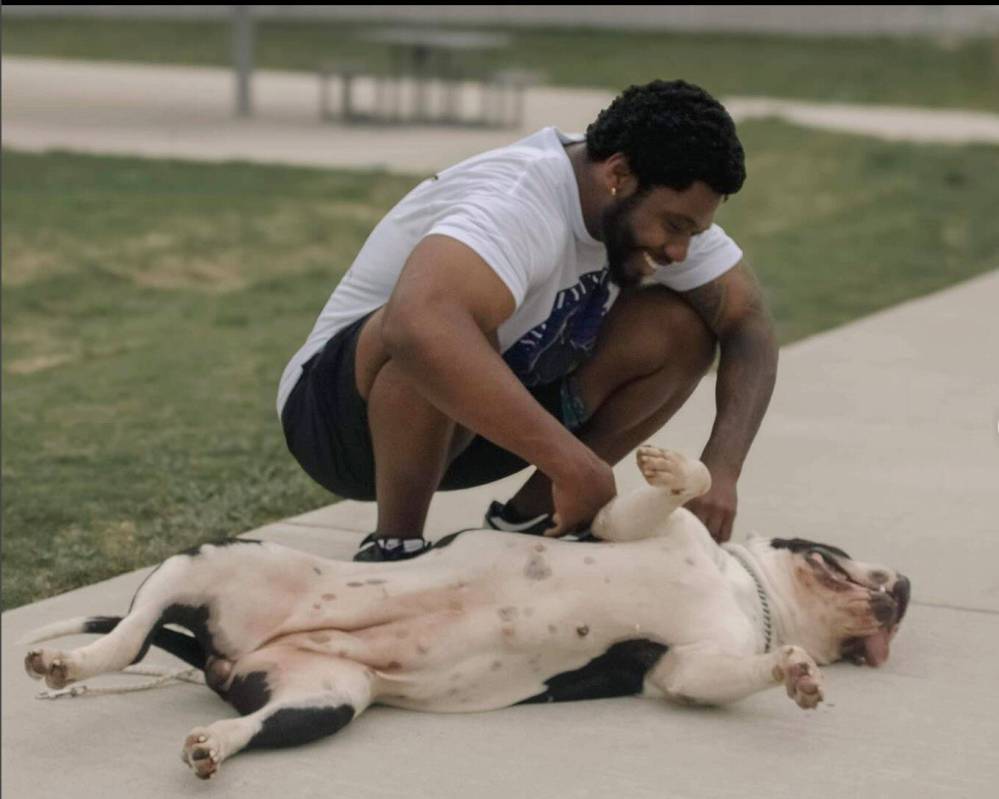Brady Oliveira isn’t the only Winnipeg Blue Bombers running back who has a passion for furry, four-legged friends.
Rookie Chris Smith — the team’s return specialist who is also the No. 3 tailback on the depth chart — has been breeding American bully dogs since his time at the University of Louisiana-Lafayette.
“I actually got a pit bull when I was in elementary. We moved to a new house and the first week I had him, somebody stole him when he was just a puppy… We moved out of that house pretty quickly after that,” said Smith, a Mississippi native, after Wednesday’s closed practice. “I just have a love for dogs, man. When I got to college, I figured out what a true American bully was, so I went out and bought one… But now, I have an even better one and she’s full of muscle. The shorter the dog, the more muscle it can carry and it’s beautiful.”
Jeff McIntosh / The Canadian Press files Blue Bombers RB Chris Smith has a passion for American Bully dogs.
The American bully is a companion dog that shares some ancestry with pit bulls and bulldogs. They’re controversial, as their strength and potential for aggression has led to them being banned or restricted in some areas and countries. If raised and trained correctly, they’re friendly and extremely loyal, but they are prohibited in Winnipeg as they have a similar appearance and physical characteristics as pit bulls.
“I saw pit bulls are banned in Winnipeg and I understand that… You can let one loose and they’ll probably try to fight every dog in the yard just because that’s their instinct because they were bred to fight,” said Smith. “The American bully, they’re more like a designer dog, a fashion dog. But it’s the look (that worries people). If you see an American bully, they’re like a bodybuilder and they just look like a bully… But they’re the most precious dogs ever. My dog I got now, Panda, she’s real big and muscular, but she’s shy as can be and loves people.”
“Some people just mislabel dogs. Some people think every dog that looks like a pit bull is a pit bull but they’re not.”
Instagram Blue Bombers running back Chris Smith with his American bully, Panda.

While Oliveira — who has worked with K9 Advocates to rescue hundreds of animals across Manitoba — is a big believer in “Adopt, Don’t Shop,” he does agree with Smith about bully breeds.
“In my rescue work we come across bully breeds all the time and it makes it difficult for us to bring them into rescue because now we’re having to find a foster that’s outside the city limits, or we have to find transports for the dog to leave the province to go to a rescue shelter that can take bully breeds. They have a bad stigma around them, but bully breeds are some of the most amazing dogs out there. They’re compassionate, loving, intelligent but just have a bad rep about them,” said Oliveira.
“If you look at the United States and the kill shelters, bully breeds are the No. 1 breed in the U.S. that are being euthanized on the daily. It’s unfortunate… I always say this: there are no bad dogs, there are bad owners.”
Breeding in general is no stranger to controvery either. If not done properly, it’s unethical, and it can also be viewed as unneccessary since so many shelters are overrun with animals who desperately need homes.
“I don’t love everbody that breeds. I also don’t mind people that do breed. It’s not (about) breeding for money. I probably breed once or twice a year… I just take my time with it,” said Smith.
“If you see an American bully, they’re like a bodybuilder and they just look like a bully … But they’re the most precious dogs ever.”–Chris Smith
“It’s hard to explain (what I enjoy about it), but with selective breeding, it’s seeing what you can create other than just like a normal dog that somebody else has. I do ABKC (American bully Kennel Club) dog shows where you win trophies. It’s like (competing in) football, but with dogs.”
Smith, 24, eventually wants to get into horse breeding, but for now, it’s a dog’s life. He plans to return home during the Week 10 bye to catch up with his pals with paws.
As much as he misses his trio — Panda, Remi and Delta — he’s glad he decided to give the CFL a shot. Smith was cut by the Seattle Seahawks in rookie camp, then drafted to the XFL only to get released before training camp began. When his agent called him about the Canadian game, Smith was initially leaning towards a coaching job-offer before changing his mind.
Smith is fifth in punt return average (11.3) and eighth in kick returns (20.1) in the three games he’s played since taking over for fellow rookie Myron Mitchell.
He’ll look to further improve those numbers Friday when the Bombers (1-4) host the Calgary Stampeders (2-2) at 7:30 p.m.
“Last year at this time, (my wife and I) were in New York and we could see Ontario from across the Niagara Falls River. And it’s crazy because I’m here (in Canada) now and we never thought we’d be here,” said Smith.
“I’m happy.”
Smith got everyone’s attention in the second and final preseason game when he returned a punt 109 yards for a touchdown. He’s hoping he’ll find the end zone in a game that counts soon, and to do so, he believes he needs to channel his dogs.
“When they’re playing, they play rough, and I can play rough, too. It’s coming, it’s coming soon.”
X: @TaylorAllen31

Taylor Allen
Reporter
Taylor Allen is a sports reporter for the Winnipeg Free Press. Taylor was the Vince Leah intern in the Free Press newsroom twice while earning his joint communications degree/diploma at the University of Winnipeg and Red River College Polytechnic. He signed on full-time in 2019 and mainly covers the Blue Bombers, curling, and basketball. Read more about Taylor.
Every piece of reporting Taylor produces is reviewed by an editing team before it is posted online or published in print — part of the Free Press‘s tradition, since 1872, of producing reliable independent journalism. Read more about Free Press’s history and mandate, and learn how our newsroom operates.
Our newsroom depends on a growing audience of readers to power our journalism. If you are not a paid reader, please consider becoming a subscriber.
Our newsroom depends on its audience of readers to power our journalism. Thank you for your support.


